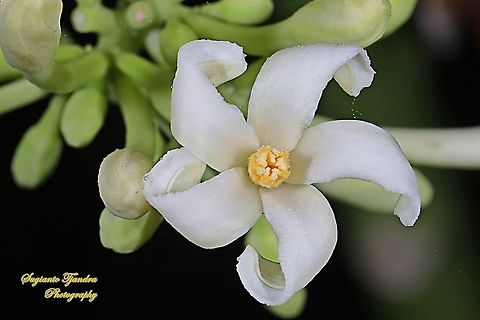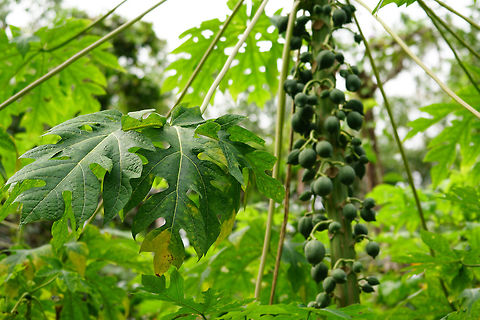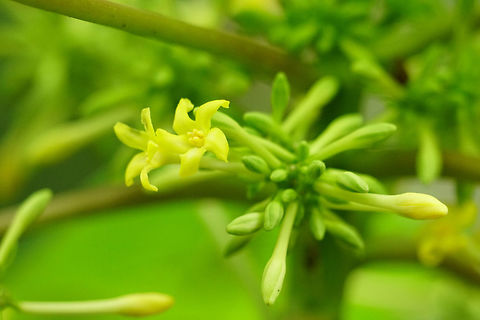
Appearance
The papaya is a large, tree-like plant, with a single stem growing from 5 to 10 m (16 to 33 ft) tall, with spirally arranged leaves confined to the top of the trunk. The lower trunk is conspicuously scarred where leaves and fruit were borne. The leaves are large, 50–70 cm (20–28 in) in diameter, deeply palmately lobed, with seven lobes. Unusually for such large plants, the trees are dioecious. The tree is usually unbranched, unless lopped. The flowers are similar in shape to the flowers of the Plumeria, but are much smaller and wax-like. They appear on the axils of the leaves, maturing into large fruit - 15–45 cm (5.9–17.7 in) long and 10–30 cm (3.9–11.8 in) in diameter. The fruit is ripe when it feels soft (as soft as a ripe avocado or a bit softer) and its skin has attained an amber to orange hue.Papaya plants grow in three sexes: male, female, and hermaphrodite. The male produces only pollen, never fruit. The female will produce small, inedible fruits unless pollinated. The hermaphrodite can self-pollinate since its flowers contain both male stamens and female ovaries. Almost all commercial papaya orchards contain only hermaphrodites.

Distribution
Papaya is native to Central and northern South America and has become naturalized throughout the Caribbean Islands, Florida and several countries of Africa. Additional crops are grown in India, Australia, the Philippines, and the U.S. state of Hawaii.
Uses
Papayas can be used as a food, a cooking aid and in traditional medicine. The stem and bark may be used in rope production.India and Brazil are the major producers of papaya, together providing 57% of the world total of 12.4 million tons in 2013 (FAOSTAT chart).
Gaining in popularity among tropical fruits worldwide, papaya is now ranked fourth in total tropical fruit production after bananas, oranges, and mango. Global papaya production has grown significantly over the last few years, mainly as a result of increased production in India. Papaya has become an important agricultural export for developing countries, where export revenues of the fruit provide a livelihood for thousands of people, especially in Asia and Latin America.
Both green papaya fruit and the tree's latex are rich in papain, a protease used for tenderizing meat and other proteins. Its ability to break down tough meat fibers was used for thousands of years by indigenous Americans. It is now included as a component in powdered meat tenderizers.
References:
Some text fragments are auto parsed from Wikipedia.